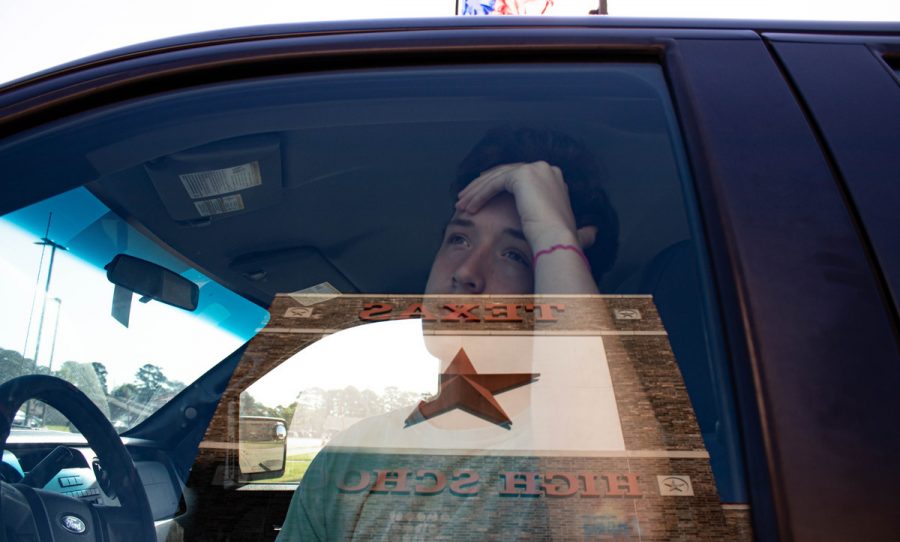The light at the end of this tunnel
COVID-19’s timetable unclear amidst constant speculation, conflicting studies
Photo by Caden Rainwater
Junior Cort Rainwater sits isolated in his truck while looking out at the Texas High School Campus. Students did not return to in-person classes following spring break due to COVID-19.
May 1, 2020
The American public would all like to believe the best in each other. We would like to believe that every citizen is willing to self-isolate as long as needed. We would like to believe that citizens will heed government warnings to forgo gatherings and work from home. We would like to believe that when making decisions in the age of the Coronavirus, people won’t hesitate to put economics, social lives, and comfort aside as long as need be in the effort to save human lives.
The problem is however, these beliefs are false. No doubt, even if you deny it, you’ve seen this in your own life. Every time the social distancing guidelines are extended, or a new government rule is put in place to reduce transmission, you can’t help having the following thoughts dance in the corners of your mind: “Oh, I’m sure that rule is an overreaction.” “I’m sick of this; when will things get back to normal”, or even “Maybe we should have just let this thing run its course.” These thoughts, however much guilt they bring once you acknowledge them, are natural. It’s human nature to put yourself and those close to you before others, so when no one in your immediate circle is at extreme risk, it can be quite hard to accept these precautions.
However, and this is the true challenge of the Coronavirus, we mustn’t let these thoughts influence our behaviors. Not when we’ve come this far. All of these measures put in place, they have merit. We’ve seen things like social distancing work wonders to “flatten the curve” in other parts of the world, so that’s not the question. The question we are asking with every coming day is one that raises answers we’d rather not confront; when will this all end?
Well, when looking to see when these guidelines and restrictions will formally be ended, it makes the most sense to look towards the government organizations that actually have the ability to raise these precautions. It would be a mistake to take the clouds of speculation from other sources as facts. When answering the question of when can we expect a return to normalcy, there is little to no consensus.
The White House extended its “social distancing” guidelines through to April 30. However, other federal organizations suggest limiting group meetings through May 15 at the earliest, if not later. Leading experts postulate that stringent social distancing initiatives could be extended in states into June.
According to officials including Dr. Tedros Ghebreyesus, the director-general of the World Health Organization, expects that those guidelines will once again be updated as COVID-19 continues to spread, which is why many school districts have closed for the remainder of the academic year.
“The last thing any country needs is to open schools and businesses, only to be forced to close them again because of a resurgence,” Dr. Ghebreyesus said in a press conference on March 25.
And we can see that a resurgence in cases is much more of a possibility when looking at the pandemic on a worldwide scale. Originally, health authorities placed faith in the idea that higher temperatures might cause the virus to slow its progression. However, we’ve already seen regions south of the equator enter their summer months in some places, and it seemed the effects this had on the virus were minimal.
Another key point in determining an ‘end date’, whether possible or not, is the possibility of vaccines and treatments. The WHO originally gave an estimate of 16-18 months until an effective vaccine could be expected to be ready for widespread inoculations. There are currently trials testing the effectiveness of hydroxychloroquine, which is a commonly used anti-malaria drug. However, it would likely be months before this drug is adapted and scaled to the point where the world needs it, should these trials prove the drug promising.
Overall, there is surprisingly little substance to reassure any predictions of exact dates when this pandemic might end. After all, all models are based on data which is ever changing. As more data gathered from countries regarding the spread of the virus is put into the equations that give us an end date, that date constantly changes. What we can be sure of however, is that unfortunately it is likely that the virus will demand preventative measures going all the way into early summer.
















